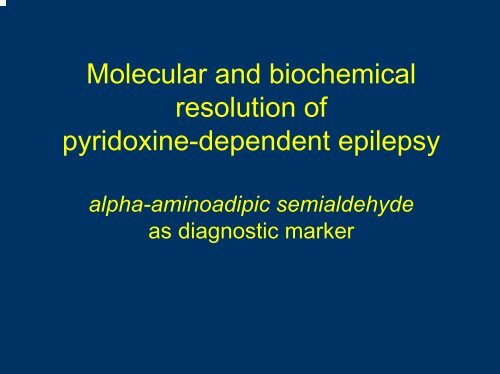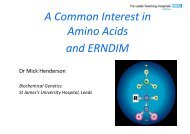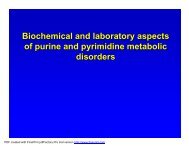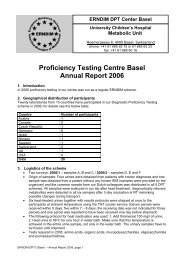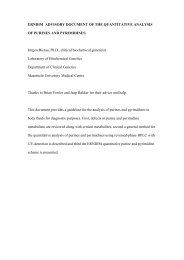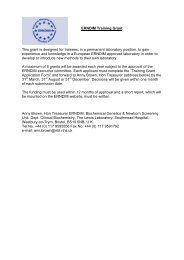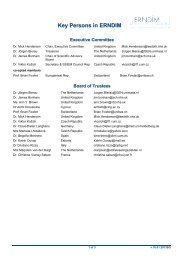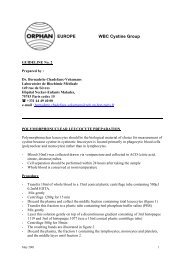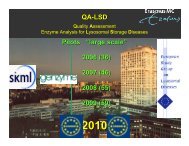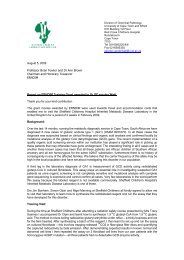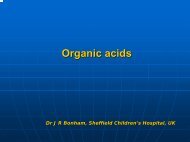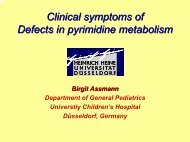pyridoxine-dependent epilepsy - ERNDIM
pyridoxine-dependent epilepsy - ERNDIM
pyridoxine-dependent epilepsy - ERNDIM
You also want an ePaper? Increase the reach of your titles
YUMPU automatically turns print PDFs into web optimized ePapers that Google loves.
Molecular and biochemical<br />
resolution of<br />
<strong>pyridoxine</strong>-<strong>dependent</strong> <strong>epilepsy</strong><br />
alpha-aminoadipic semialdehyde<br />
as diagnostic marker
Pyridoxine-<strong>dependent</strong> seizures<br />
• First described in 1954<br />
• Neonatal seizures beginning in the first few days of life<br />
• Cessation of seizures after administration of 50-100mg <strong>pyridoxine</strong><br />
Continued seizure control on 15 mg/kg/d <strong>pyridoxine</strong><br />
Seizure recurrence if <strong>pyridoxine</strong> is withdrawn<br />
• Autosomal recessive<br />
• No gene has been identified; favoured hypothesis was defect in glutamate<br />
decarboxylase (GAD)<br />
• maps to 5q31.2 – q31.3 (Cormier-Daire et al., Am J Hum Genet, 2000)
Pyridoxine-<strong>dependent</strong> seizures<br />
• Elevated concentrations of pipecolic acid in plasma and CSF<br />
• Defect in PLP-<strong>dependent</strong><br />
step in lysine<br />
degradation<br />
pathway ?<br />
2-keto-6-amino caproic acid<br />
L-Lysine<br />
∆1-Piperideine 2-carboxylic acid<br />
Saccharopine<br />
Pipecolic acid<br />
∆1-Piperideine 6-carboxylic acid<br />
L-2-Aminoadipate 6-semialdehyde<br />
L-2-Aminoadipate<br />
Aminoadipate<br />
PLP<br />
2-Oxoadipate<br />
Acetyl-CoA<br />
α-aminoadipate<br />
aminoadipate transaminase
Pyridoxine-<strong>dependent</strong> seizures<br />
• similar scenario to that of hyperprolinaemia type II ?<br />
P5C<br />
P5C dehydrogenase<br />
L-Proline<br />
L-Glutamic acid<br />
L-Glutamic-γ-semialdehyde<br />
L-Ornithine<br />
L-glutamic acid<br />
P5C reacts with PLP to inactivate it<br />
P6C<br />
Pipecolic acid<br />
L-2-Aminoadipate<br />
L-2-Aminoadipate 6-semialdehyde<br />
????
Pyridoxine-<strong>dependent</strong> seizures<br />
N COOH<br />
∆ 1 -Piperideine-6-carboxylic acid<br />
P6C<br />
N<br />
COOH<br />
L-∆ 1 -Pyrroline-5-carboxylic acid<br />
P5C<br />
2-keto-6-amino caproic acid<br />
L-Lysine<br />
∆1-Piperideine 2-carboxylic acid<br />
Saccharopine<br />
Pipecolic acid<br />
∆ 1 -Piperideine 6-carboxylic acid<br />
L-2-Aminoadipate 6-semialdehyde<br />
L-2-Aminoadipate<br />
Aminoadipate<br />
2-Oxoadipate<br />
Acetyl-CoA
Pyridoxine-<strong>dependent</strong> seizures<br />
P6C dehydrogenase (S. clavuligerus)<br />
FAAVGTAGQRCTTLRRL<br />
C. elegans P6C; P. sativum P6C<br />
B. subtilis P5C<br />
ANTIQUITIN<br />
(ATQ1; ALDH7A1)<br />
Maps to 5q31<br />
2-keto-6-amino caproic acid<br />
∆ 1 -Piperideine 2-carboxylic acid<br />
Pipecolic acid<br />
∆ 1 -Piperideine 6-carboxylic acid<br />
L-Lysine<br />
Saccharopine<br />
L-2-Aminoadipate 6-semialdehyde<br />
L-2-Aminoadipate<br />
Aminoadipate<br />
2-Oxoadipate<br />
Acetyl-CoA
Antiquitin (ALDH7A1)<br />
• First described in peas – cellular turgor pressure<br />
• Highly conserved across species<br />
• Belongs to the superfamily of aldehyde dehydrogenases<br />
• Shown to have acetaldehyde dehydrogenase activity<br />
• Exact physiological role has not previously been elucidated
Antiquitin (ALDH7A1)<br />
• Mutations in the antiquitin gene cause <strong>pyridoxine</strong><strong>dependent</strong><br />
<strong>epilepsy</strong> in man.
Pathophysiologic mechanism in PDE:<br />
analogy to hyperprolinemia type II<br />
N COOH<br />
+<br />
HO<br />
C<br />
H 3<br />
O<br />
N<br />
O P<br />
O<br />
OH<br />
OH<br />
Piperideine-6-carboxylic acid (P6C) Pyridoxal 5-Phosphate<br />
HO<br />
C<br />
H 3<br />
HO<br />
Mw 127<br />
N<br />
N COOH<br />
O P<br />
O<br />
OH<br />
OH<br />
HO<br />
C<br />
H 3<br />
Mw 247<br />
N<br />
N COOH<br />
O P<br />
O<br />
OH<br />
OH<br />
complex A complex B<br />
Mw 374 Mw 356<br />
2-keto-6-amino caproic acid<br />
L-Lysine<br />
∆1-Piperideine 2-carboxylic acid<br />
Saccharopine<br />
L-pipecolic pipecolic acid<br />
∆ 1 -Piperideine 6-carboxylic acid<br />
L-2-Aminoadipate 6-semialdehyde<br />
L-2-Aminoadipate<br />
Aminoadipate<br />
2-Oxoadipate<br />
Acetyl-CoA
Pathophysiologic mechanism in PDE<br />
P6C + PLP complex A + complex B<br />
Experiment: Aqueous solution<br />
T 0<br />
T 24<br />
-PLP<br />
PLP<br />
1 mmol/L P6C<br />
1 mmol/L PLP<br />
pH 7.5<br />
37°C, 24 hours<br />
complex B<br />
m/z –246 m/z –355 m/z -373<br />
complex A<br />
Hypothesis of PLP deactivation by complexation<br />
with P6C appeared to be true (in-vitro).
L-2-Aminoadipate 6-semialdehyde<br />
O=C-CH 2 -CH 2 -CH 2 -CH-COOH<br />
H NH 2<br />
2-keto-6-amino caproic acid<br />
L-Lysine<br />
∆1-Piperideine 2-carboxylic acid<br />
Saccharopine<br />
L-pipecolic pipecolic acid<br />
∆ 1 -Piperideine 6-carboxylic acid<br />
L-2-Aminoadipate 6-semialdehyde<br />
L-2-Aminoadipate<br />
Aminoadipate<br />
2-Oxoadipate<br />
Acetyl-CoA
L-2-Aminoadipate 6-semialdehyde<br />
determination<br />
- Matrices: cerebrospinal fluid, plasma, and urine.<br />
- 15 N-aminoadipic acid used as internal standard.<br />
- Convert AASA and IS to corresponding FMOC-derivatives.<br />
- Measurement performed by LC-MS/MS in MRM mode.
L-2-Aminoadipate 6-semialdehyde<br />
determination<br />
AASA in bodyfluids of patients with <strong>pyridoxine</strong>-<strong>dependent</strong> seizures<br />
Cohort 1<br />
patients controls<br />
CSF (µmol/L) 1; 28; 19
L-2-Aminoadipate 6-semialdehyde<br />
a novel biomarker for PDE?<br />
Increase of biomarker in bodyfluids of PDE patients<br />
2 cohorts<br />
CSF<br />
plasma<br />
AASA L-pipecolic acid<br />
urine nl.-<br />
* nl. on-therapy, elevated off- (before) therapy<br />
Yes, a non-invasive specific diagnostic metabolite for PDE,<br />
in<strong>dependent</strong> whether patients are on/off therapy!<br />
*
CONCLUSIONS<br />
AASA is consistently increased in body fluids derived from PDE patients<br />
(now found in two cohorts).
CONCLUSIONS<br />
AASA is consistently increased in body fluids derived from PDE patients.<br />
Since AASA is in equilibrium with P6C, P6C is expected to be increased.
CONCLUSIONS<br />
AASA is consistently increased in body fluids derived from PDE patients.<br />
Since AASA is in equilibrium with P6C, P6C is expected to be increased.<br />
P6C complexate with PLP in-vitro: supporting the hypothesis of<br />
PLP-deactivation in PDE.
CONCLUSIONS<br />
AASA is consistently increased in body fluids derived from PDE patients.<br />
Since AASA is in equilibrium with P6C, P6C is expected to be increased.<br />
P6C complexate with PLP in-vitro: supporting the hypothesis of<br />
PLP-deactivation in PDE.<br />
Increases of AASA revealed that antiquitin acts on AASA, and that the<br />
metabolic impairment is located at the level of the conversion of AASA<br />
into alpha-aminoadipic acid.
CONCLUSIONS<br />
AASA is consistently increased in body fluids derived from PDE patients.<br />
Since AASA is in equilibrium with P6C, P6C is expected to be increased.<br />
P6C complexate with PLP in-vitro: supporting the hypothesis of<br />
PLP-deactivation in PDE.<br />
Increases of AASA revealed that antiquitin acts on AASA, and that the<br />
metabolic impairment is located at the level of the conversion of AASA<br />
into alpha-aminoadipic acid.<br />
AASA is a novel non-invasive diagnostic metabolite for PDE.<br />
No need for test of <strong>pyridoxine</strong> withdrawal.
Cornelis Jakobs<br />
Philippa Mills<br />
Peter Clayton<br />
Michel AAP Willemsen<br />
Levinus A Bok<br />
Participants<br />
Barbara Plecko Kerra Pearce<br />
Peter Baxter Liz Bland<br />
Matthias Baumgartner<br />
Heymut Omran<br />
Uta Tacke<br />
Birgit Uhlenberg<br />
Berhard Weschke


